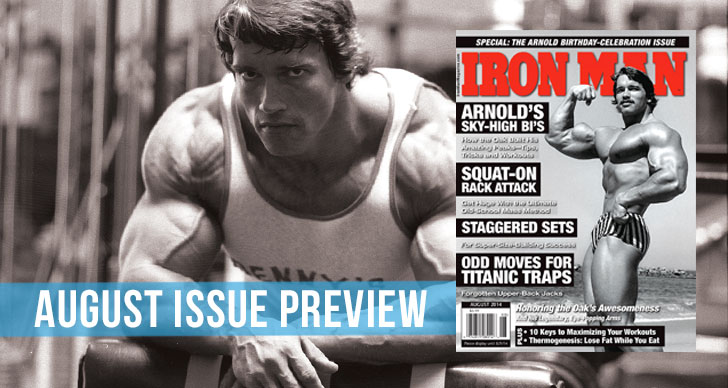 Q: I stare at the physique of Phil Heath. I’m awestruck. It’s as if he’s not human. Sometimes it inspires me, but usually I feel overwhelmed and discouraged. How can I keep myself inspired?
Q: I stare at the physique of Phil Heath. I’m awestruck. It’s as if he’s not human. Sometimes it inspires me, but usually I feel overwhelmed and discouraged. How can I keep myself inspired?
A: When I started out in bodybuilding in the early 1970s, the difference between the average bodybuilder and the elite bodybuilders of that era was huge; but today the difference is far greater, primarily due to the more effective bodybuilding drugs available and also because there’s probably a greater number of genetic phenomena involved in elite bodybuilding.
Draw inspiration and encouragement from others when possible, but keep your main focus on doing the best you possibly can. Get each day right, each week right, each month right, and the results will happen in line with your genetically determined capability for bodybuilding. If you do that for a few years, you’ll develop a physique that will make most people’s jaws drop at a swimming pool or beach. While you’ll never be able to match Phil’s physique—or that of any elite bodybuilder—you will be stunning by almost all other standards.
Q: Should I do Roman-chair situps or regular crunches?
A: Roman chairs come in different forms. Most have you in a seated-calf-raise position, feet braced, and you lie back until your torso is parallel to the floor. Some Roman chairs are riskier than others, depending on the apparatus used, the specific technique used and the condition of the user. Some put such great stress on the lower back that they are very dangerous—because they train the hip flexors much more than they train the abs, and because of the excessive range of motion that’s often used.
I recommend that you forget about Roman-chair situps and stick with crunches. Use a crunch machine or do floor crunches with your calves across a bench and a dumbbell on your chest. Don’t arch your lower back at any stage of a crunch, avoid an excessive range of motion, and use a controlled rep speed, pausing for a second at both the top and the bottom of each rep.
Another point: Don’t fall for the myth that ab work will reduce fat around your waist. Ab exercises will develop your ab muscles, if done correctly, but whether you can see your six-pack depends on how much fat is there. To reduce it, you need to reduce the fat over your whole body, which means creating a calorie deficit in order to draw on your energy reserves, a.k.a. bodyfat. Avoid fast weight loss, though, or you’ll lose fat and muscle. Keep it to no more than one pound a week, and train hard with the weights (without overtraining) to try to lose fat without losing muscle.
Q: I can barely do five chins, but I keep hearing that the chinup is a great exercise. I’m starting to dislike it because I don’t seem to be able to progress on it. What should I do?
A: Stick with pulldowns to the front until you can handle 10 pounds or so more than your bodyweight on the weight stack for at least six perfect reps. Then move to chinning (which means to your clavicles, not to behind your head). Chinups involve a supinated grip, meaning your palms are facing you, with your hands spaced shoulder width or a little closer, according to what works best. If chinups are uncomfortable for your wrists or your elbows no matter how you fine-tune your hand spacing, try pullups, which involve a pronated grip, meaning your palms are facing away from you, with your hands a little wider than shoulder width.
Q: While on vacation I trained at a gym that had a shoulder-width parallel-grip bar for the low-pulley row, which produced a much more effective workout for my lats and the rest of my upper back than the close-parallel-grip bar I use at my regular gym. Why aren’t the shoulder-width bars more commonly available?
A: The use of a close-parallel-grip bar has a long tradition, and entrenched views take time to shift. Some entrenched views in bodybuilding are based on misunderstandings and errors, but still they are commonly held and passed on to new bodybuilders as facts.
When you use the close-grip bar and your hands are at your chest, your elbows are flared outward, and you pull outward to a large extent. With a shoulder-width bar, however, your forearms are parallel to each other, and you pull directly to the rear, which is what you want for this exercise.
Now that you’ve discovered the benefit of a shoulder-width parallel-grip bar for low-pulley rows, you’re a believer, and you can help spread the word. Encourage the management of your regular gym to get a shoulder-width parallel-grip bar for the benefit of all members.
You don’t want to move from a close-parallel-grip bar to a very wide parallel grip. The very wide bars are commonly available, but in fact they are too wide for anyone other than huge men. Use a bar that has the handles spaced to suit the shoulder width of typical people. A gym should have two or three bars of varying handle widths to accommodate users of different sizes. An adjustable bar would be ideal.
—Stuart McRobert
www.Hardgainer.com
Editor’s note: Stuart McRobert’s first byline in IRON MAN appeared in 1981. He’s the author of the new BRAWN series, Book 1: How to Build Up to 50 Pounds of Muscle the Natural Way, available from Home Gym Warehouse (800) 447-0008 or www
.Home-Gym.com.





















You must be logged in to post a comment Login